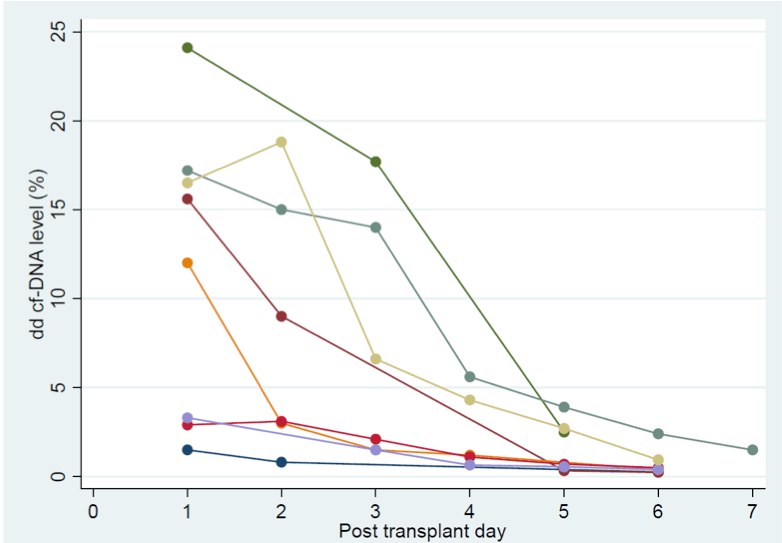Donor Derived Cell-free DNA Kinetics Early After Kidney Transplant in Patients with Delayed Graft Function Who Received Kidneys from Donation After Cardiac Death Donors
Division of Nephrology, Johns Hopkins University School of Medicine, Baltimore, MD
Meeting: 2021 American Transplant Congress
Abstract number: 1030
Keywords: Donors, non-heart-beating, Graft function, Kidney transplantation, Monitoring
Topic: Clinical Science » Kidney » Kidney Acute Antibody Mediated Rejection
Session Information
Session Name: Kidney Acute Antibody Mediated Rejection
Session Type: Poster Abstract
Session Date & Time: None. Available on demand.
Location: Virtual
*Purpose: Delayed graft function (DGF) may reduce long-term kidney allograft survival due to ischemia-reperfusion injury and rejection. Donor Derived Cell-Free DNA (dd-cfDNA) is proposed to be a non-invasive marker for detection of allograft rejection and injury. Dd-cfDNA are higher in deceased than living donor recipients in the first week after Kidney Transplant (KTxp) and decrease to less than 1.0% in the absence of DGF. This exploratory study describes the kinetics of dd-cfDNA in the immediate post-transplant period in patients with DGF, which has not been studied previously, and determines its’ correlation with allograft function.
*Methods: Eight deceased-donor KTxp recipients at high risk for DGF (score of 30% or more on Irish Nomogram: Irish W et al. AJT,10:2279-2286) were enrolled after signing an informed consent. Blood samples were collected daily for 7 days post-KTxp for dd-cfDNA (AlloSure, CareDx).
*Results: Table 1 shows baseline recipient and donor characteristics. All patients had DGF with subsequent recovery of allograft function. Median duration of DGF was 9.5 days (IQR 6.5-21.8). Median nadir serum creatinine (sCr) was 1.4 mg/dL (IQR 0.98-1.8) at last follow up of 1-7 (median 2.5) months post KTxp. The dd-cfDNA kinetics for each patient is shown in Figure 1. Median dd-cfDNA level at day 1 was 14% (IQR 3-17%) and at day 7 was 0.45% (IQR 0.3-1.36%). Duration of DGF showed weak correlation with daily average decline in dd-cfDNA (R2=0.37), but no correlation with dd-cfDNA level at day 7 (R2=0.0005). There was no correlation of nadir sCr with daily average decline in dd-cfDNA (R2=0.03) or dd-cfDNA level at day 7 (R2=0.001).
| Recipient characteristics | Donor characteristics | |
| N | 8 | 7 |
| Median age | 59.5 years (IQR 44-62.8) | 51 years (IQR 28-58.5) |
| Race | 4 Black, 2 Asian, 2 White | 1 Black, 7 White |
| Sex | 3 Female, 5 Male | 3 Female, 5 Male |
| Median time on dialysis | 48.5 months (IQR 29.8-71.5) | |
| DCD | n=7 | |
| Median KDPI | 67.5% (IQR 40.5-89) |
*Conclusions: In patients with DGF who received kidneys from DCD donors, dd-cfDNA levels are elevated immediately after KTxp, but decline within the first week to <1.5%. Our data suggests that in these patients, elevated dd-cfDNA of >1.5% (3x the median) and not decreasing 7 days after KTxp warrants further investigation for the cause of persistent elevation which may include rejection, obstruction, recurrent disease etc.
To cite this abstract in AMA style:
Gumber R, Abuzeineh M, Mejia C, Brennan D, Naqvi F. Donor Derived Cell-free DNA Kinetics Early After Kidney Transplant in Patients with Delayed Graft Function Who Received Kidneys from Donation After Cardiac Death Donors [abstract]. Am J Transplant. 2021; 21 (suppl 3). https://atcmeetingabstracts.com/abstract/donor-derived-cell-free-dna-kinetics-early-after-kidney-transplant-in-patients-with-delayed-graft-function-who-received-kidneys-from-donation-after-cardiac-death-donors/. Accessed December 19, 2025.« Back to 2021 American Transplant Congress

